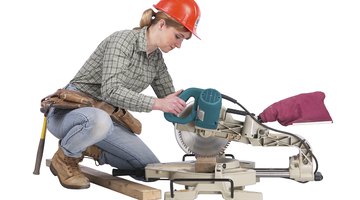How to Saw Lack Tables From Ikea
Safety glasses Marker Ruler or tape measure Masking tape Miter saw, chop saw or handsaw, or circular saw with fine-tooth blade Medium-grit sandpaper Drill Rotary tool or jigsaw Hole saw Utility knife or scissors If you need to cut the top of the table in half to create floating shelves or for other modifications, use painter's tape along the edges of the cut line to avoid splintering and damage.

The low cost and wide color selection of Ikea's Lack side table make this piece of furniture a staple in households around the globe. While Lack tables from Ikea feature a relatively simple design, handy homeowners frequently modify or hack these tables to create anything from a sound system rack to a dining table for dogs. The thin veneer layer, honeycombed cardboard core and hollow legs mean sawing a Lack table requires a light touch to avoid chips, cracks and other forms of damage.
Things You Will Need
- Safety glasses
- Marker
- Ruler or tape measure
- Masking tape
- Miter saw, chop saw or handsaw, or circular saw with fine-tooth blade
- Medium-grit sandpaper
- Drill
- Rotary tool or jigsaw
- Hole saw
- Utility knife or scissors
Tip
If you need to cut the top of the table in half to create floating shelves or for other modifications, use painter's tape along the edges of the cut line to avoid splintering and damage. The legs on a Lack table are not solid, and may require additional support if the thin plywood base of the leg is cut away. Consider adding blocks on wood to the inside of each leg for support if you modify the legs. Cutting into a Lack table from Ikea exposes the pressed wood construction, making it highly susceptible to moisture damage. Consider sealing any exposed edges to reduce swelling and warping.
Warning
Always wear safety glasses, and use caution when operating any type of saw.
Cutting Legs
-
Inspect the ends of the legs. The end with the predrilled holes is designed to screw into the tabletop, so always cut the end without the holes when you are attempting to shorten the legs.
-
Mark the location of your cuts using a marker and a ruler or tape measure.
-
Wrap each leg with a piece of painter's tape to completely encircle the leg. Place the tape so it butts up against the line you drew. Repeat to place a piece of tape around the leg on the other side of this line as well, leaving only the line itself free of tape.
-
Choose your saw. Use a miter or chop saw, or a circular saw equipped with a fine-tooth blade to cut Lack tables. You also can use a fine-tooth handsaw for this task.
-
Put on a pair of safety glasses and position the cut line on the table leg beneath the blade. Lower the blade, using a low angle if you are using a handsaw, and cut slowly and carefully through the leg. The painter's tape on either side of the cut line helps reduce splintering and splitting.
-
Sand the cut edges with a piece of medium-grit sandpaper to smooth them out as desired.
Cut a Hole in the Tabletop
-
Mark the dimensions of your hole on the tabletop using a marker and ruler.
-
Put on safety glasses and drill through each of the four corners of the hole. Allow the drill to pass through the thin layer of veneer at the top of the table, but do not allow it to extend all the way through the bottom of the table unless you plan to completely remove a section of tabletop.
-
Use a jigsaw or rotary tool to cut through the top layer of the tabletop, using the predrilled holes as a guide. Remove this layer once you cut around its perimeter.
-
Cut through the exposed honeycomb cardboard core using a pair of scissors or a utility knife. Remove this section of core.
-
Use a jigsaw or rotary tool to remove the bottom layer of the table, if desired for your project.
-
Sand the cut edges of the table smooth using a medium-grit sandpaper.
The Drip Cap
- The low cost and wide color selection of Ikea's Lack side table make this piece of furniture a staple in households around the globe.
- Inspect the ends of the legs.
- The end with the predrilled holes is designed to screw into the tabletop, so always cut the end without the holes when you are attempting to shorten the legs.
- Sand the cut edges with a piece of medium-grit sandpaper to smooth them out as desired.
- Put on safety glasses and drill through each of the four corners of the hole.
References
Resources
Writer Bio
Emily Beach works in the commercial construction industry in Maryland. She received her LEED accreditation from the U.S. Green Building Council in 2008 and is in the process of working towards an Architectural Hardware Consultant certification from the Door and Hardware Institute. She received a bachelor's degree in economics and management from Goucher College in Towson, Maryland.
Photo Credits
- Hemera Technologies/PhotoObjects.net/Getty Images
- Hemera Technologies/PhotoObjects.net/Getty Images
More Articles



